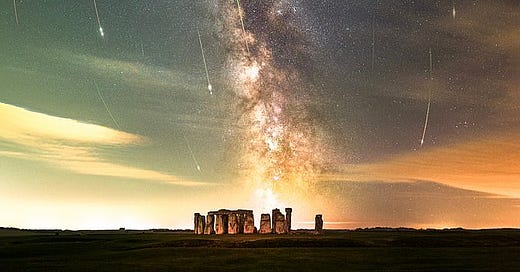Notes from an Environmentalist.
How an Asteroid Created Modern Birds, Reflections on the Perseids.
Perseids over Stonehedge.
How an Asteroid Created Modern Birds;
Reflections on the Perseids
I have learned to always heed the call of nature, whether it be the poetic Jack London kind or the more bladder induced sort.
Last night it was the more prosaic type but it got me out of bed at 2am, the perfect time to see the Perseid meteor shower.
I had tried to watch the shower at dusk only to be plagued by a bright moon, overcast skies even yellow jackets that chased me inside.
But 2 am was perfect timing. The moon had set at midnight and Jupiter and Mars were glowing near Perseus, the best place to look for the shooting stars.
The Perseids are pieces of the Swift-Tuttle Comet the largest object that passes by earth. The last time it passed close to earth was 1992 and it won’t return till 2116.
But as the earth passes through the comet’s tail every year, fragments of its rock and ice slam into the earth’s atmosphere, 85 faster than the speed of a jet. This heats up the fragments to thousands of degrees so they become the much sought after, “shooting stars”.
The most famous meteor that became a meteorite was Chicxulub. It slammed into the earth off the Yucatan Peninsula and threw up a dense cloud of ash and sulphur-based gases creating a cold “impact winter” that wiped out the dinosaurs.
The only animals that were able to survive the holocaust were creatures like horseshoe crabs that could hide in the sediments not eating until the gas, smoke, ash, and wildfires dissipated.
The other creatures were a group of avian dinosaurs that could migrate to safer locations.
Today we see the results in the DNA of the 10,000 species of existing birds. After the impact, they evolved to be much smaller than their dinosaur ancestors, and to have their offspring mature more slowly.
So today, most of bird chicks mature slowly and their parents spend considerable time and energy feeding them.
The exception that proves the rule are the few species like ducks, chicken and piping plover whose chicks are born already able to walk and feed themselves.
It is no coincidence that piping plover are endangered and that ducks and chickens are the most numerous birds on our planet because they have co-evolved with humans. In other words, they have trained us to feed and raise them.
So think of these ramifications as you enjoy the Perseids that should continue to thrill through the remainder of the delightfully warm days and cool nights of this August.




